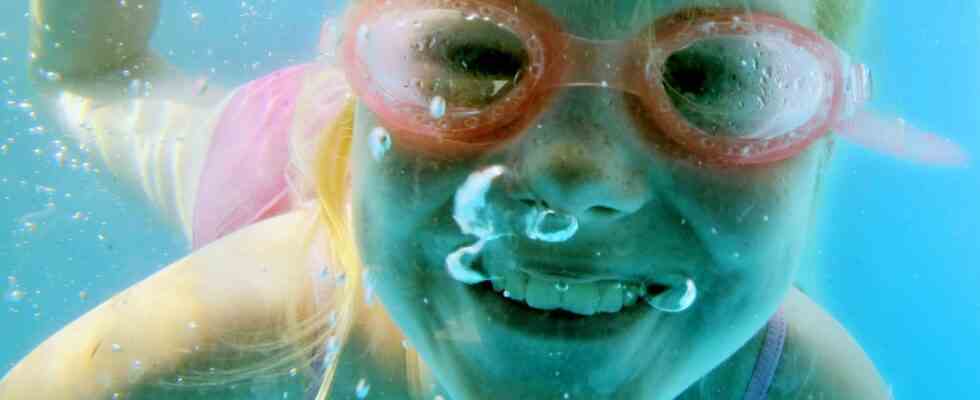Survey of non-swimmers
To learn how to swim? It also depends on the income of the parents
Learning to swim can also be a lot of fun. More children are learning it in higher-income households than in poorer families, a new survey shows.
© Roland Weihrauch
Learning to swim is vital. But many children in Germany cannot, or only insufficiently, do it. There are a number of reasons for this, one of which appears to be parental income.
Why do children learn to swim or why don’t they learn it? Basically, it’s simple: Fewer swimming pools means fewer swimming lessons – and less confident swimmers. During the corona pandemic, there were times when there were no swimming lessons at all. The result: According to a new Forsa survey, the proportion of non-swimmers among primary school children in Germany has doubled within five years.
Last year, 20 percent of children between the ages of six and ten could not swim – five years earlier it was 10 percent, said the German Life Saving Society in Bad Nenndorf. “The difference is serious, but given the developments over the past two to three years, it’s not surprising,” said DLRG President Ute Vogt. She warned: “Just as boys and girls learn to read, write and do arithmetic, they must also learn to swim. We must ensure that every child can swim safely by the end of primary school.”
The DLRG, according to its own statements Germany’s largest private provider of swimming training, had commissioned the representative survey. The last comparable study to date was in 2017. In August 2022, 2000 people aged 14 and over were surveyed nationwide. Among other things, it was about whether they rated themselves as non-swimmers, unsafe swimmers or confident swimmers.
At 57 percent, the proportion of children who are classified by their parents as safe swimmers has remained almost the same in the past year – in 2017 it was 59 percent, in 2010 even 64 percent. The proportion of supposedly safe swimmers increases with age: 26 percent of the parents of six-year-olds stated that their child was already able to swim safely. For ten-year-olds it was 83 percent. Only: From the DLRG’s point of view, many parents find this assessment difficult. “Mothers and fathers are still all too often of the opinion that their child can swim if it has the seahorse,” said Christian Landsberg, head of training at the DLRG Presidium. “They’re on the wrong track there.”
Learning to swim is not done with the seahorse
Because the seahorse certifies that you have mastered important basics, Landsberg explained that you can only swim safely if you have passed the free swimmer, i.e. the bronze badge. However, 21 percent of the children who, according to their parents, can swim safely or at least unsafely, did not complete a single badge. The DLRG assumes that six out of ten children or 58 percent at the end of elementary school are not confident swimmers.
The survey showed that more than every second child (54 percent) between the ages of six and ten has the seahorse, in 2017 it was 69 percent. 24 percent of the children have completed the Freischwimmer, 13 percent can prove silver and three percent gold. Among children aged ten and over, 42 percent have completed the Freischwimmer, 24 percent have silver and eight percent have gold. Half of those surveyed said they could swim well or very well. Only 35 percent of people with a secondary school leaving certificate judged themselves to be good swimmers, 38 percent of people with a migration background – and only 37 percent of those over 60.
Low net income, few safe swimmers
“What surprised us in terms of clarity is the difference in income,” said Vogt. According to the survey, almost half (49 percent) of children from households with a monthly net income of less than 2,500 euros cannot swim – with a household net income of more than 4,000 euros it is twelve percent. Vogt emphasized: “Being able to swim shouldn’t be a question of money. It’s all the more important that every school is able to teach swimming appropriately.”
However, baths are necessary for this. But during the energy crisis, according to a recently published survey by the consulting firm Ernst & Young, almost every third municipality in Germany wants to close indoor and outdoor swimming pools or restrict operations, and many have already done so. The trainers notice that too: the lower water temperature makes it difficult for the youngest to train, said Arne Grosser, DLRG swimming trainer from Hanover. “We scheduled an hour for the seahorse group on Thursdays, but usually we can’t make full use of the time. At some point, the children are frozen through and have to get out earlier. It then takes longer than usual to reach the course goal.” In addition, because of the high demand, 30 children are in the course – “much more than desirable”.
According to the Forsa figures, 87 percent of those surveyed have an accessible swimming pool in the vicinity. In 2017 it was 92 percent. For people from places with fewer than 5,000 inhabitants, it was 78 percent – after 90 percent five years ago. “These results indicate that the trend in pool supply continues to go in the wrong direction,” criticized Vogt.
“Pack your swimming trunks”
Headfirst into the water: These are Germany’s most beautiful bathing spots
Take a look at the photo series: where is the best place to have fun in Germany’s most beautiful rivers, lakes and coasts? The book “Pack your swimming trunks” reveals more than 100 places to cool off, swim and stand-up paddleboard.

